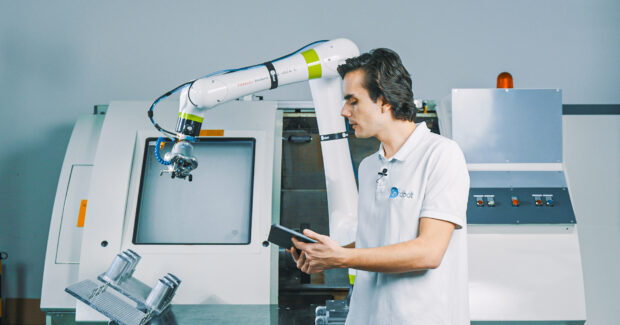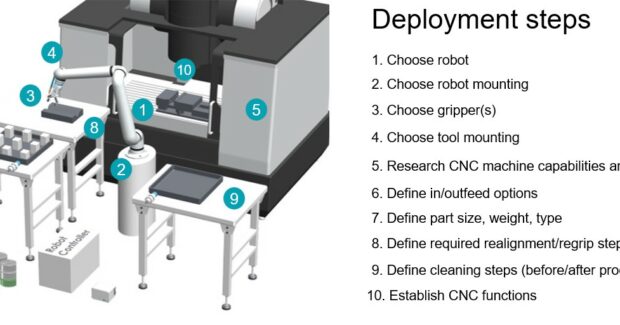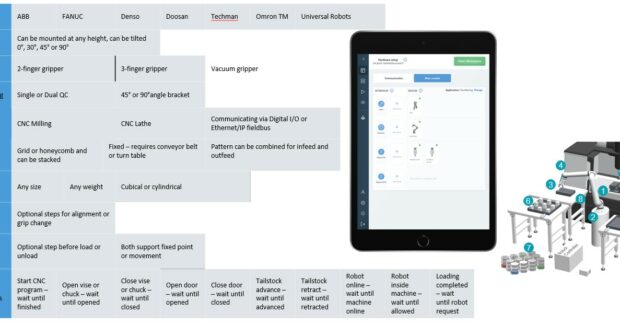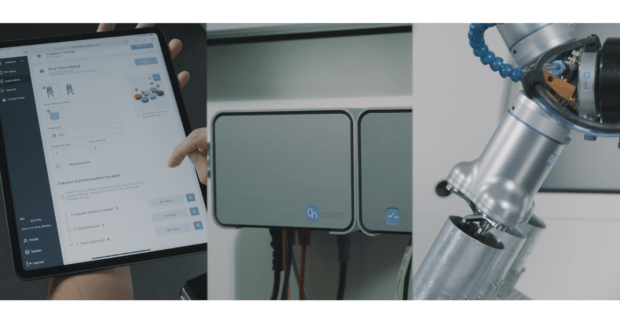Zero-Programming Simplifies Collaborative Automation
Zero-programming deployment puts collaborative automation in reach for fabricators.
Posted: August 15, 2023

Fabricators of all sizes continue to push for increased productivity and capacity while reducing costs and labor dependencies, especially for repetitive, hard-to-staff tasks. Automation — especially today’s affordable, easier-to-use collaborative and light industrial robots — offer tremendous promise. But small and mid-sized enterprises (SMEs) still face barriers to unlocking the benefits of automation, even with advances that have made collaborative automation easier to program and use. The remaining challenge is often higher-than-expected costs that are driven by application complexity, long deployment time, and ongoing dependence on outside integration resources.
While collaborative automation can be fast and easy to deploy for straightforward processes, many fabricators find that their ideal application is actually more sophisticated than they assumed and requires the expertise of an integrator. Once programmed, redeployment for new products or to add productivity improvements can also be challenging, which can make it harder for shops with high-mix, low-volume production to justify a robotics investment. While manufacturers are happy to rely on integration experts for initial deployment, most want to take over from there, managing the equipment in-house as needed to meet changing business needs. And in fact, most integrators have that goal as well. Labor shortages impact integrators too, so the faster they can successfully hand off a robotics initiative to customers, the sooner they can move limited resources onto new deployment projects.
Fortunately, industrial automation continues to move forward with open, plug-and-play hardware and “no-code” programming. These changes are helping to speed deployment and enable greater flexibility and scalability for long-term return on investment (ROI). Importantly, they allow even small manufacturers to confidently take the reins of their automation initiatives, even with little or no robotic expertise in house. That’s critical for fabricators to stay profitable in the face of ongoing labor and supply chain challenges and global competition.
Robot Programming Evolves for Easier Deployment

Collaborative robots (cobots) ushered in a game-changing approach to integration, especially for straightforward applications. Instead of complex programming by experts, cobots can be programmed by moving the robot arm and end-effector into position by hand and setting various points along the way using an intuitive touch-panel-based teach pendant. As light industrial robots evolved to mimic this ease-of-use, cross-platform systems that enable speedy deployments across multiple robot brands came into play. In this ‘one system, zero complexity’ approach, a unified mechanical interface for end effectors and communication standards across robot brands simplifies deployment even more.
Recently, so-called ‘low- and no-code programming’ approaches have come to market using visual modeling and drag-and-drop user interfaces. Low-/no-code programming is an advancement, but unless the application is very simple, some programming knowledge is still required to ensure a safe and successful deployment. For many SMEs, any programming at all is enough to discourage investment in robotics.
The latest technology to appear is a platform that eliminates the need for programming altogether, an achievement that has been an industry goal for at least a decade. This technology automates the process of building, running, monitoring, and redeploying collaborative automation. That allows complete applications to be deployed and redeployed directly on the manufacturing floor in a few simple steps, with zero programming required. That helps reduce cost and risk while speeding ROI.
This new technology abstracts the programming details required for successful deployment such as path planning, program logic, signals exchange and event handling. All that complex robotics expertise is built in, so the user can simply define the cell boundaries and obstacles and the software produces an optimized program for the application. Once the automated setup is complete, users simply click to run the application and can then monitor it in real time to boost productivity and minimize downtime. That allows complete applications to be quickly deployed on the factory floor, and ongoing changes can be managed in-house with no robotics expertise.
Automated Machine Tending Example
One of the most common applications for fabricators and manufacturers to automate is machine tending. For human workers, these jobs are boring and repetitive, hard to staff, and can be prone both to repetitive injury and lack of consistency over the course of a shift. In many cases, long machine cycle times can also leave the operator standing idle for extended periods between loading and unloading the machine. All of these characteristics make these applications ideal for collaborative or light industrial robots.
But even a fairly straightforward deployment of a collaborative CNC machine tending application can take 36 hours to set up, program, test, and deploy using traditional approaches.

Machine tending automation requires expertise at each deployment step.
Robotic machine tending deployment requires expertise at each step, beginning with choosing the robot and its mounting to fit into existing shop floor layouts and to work with defined infeed and outfeed setups. Single or dual grippers must be sourced to meet workpiece size, weight, and type, and decisions must be made on how to mount the tool to meet the application needs. For instance, an end-effector quick changer allows fast and easy changeovers to handle different work pieces.
CNC machine integration requires an understanding of the machine’s capabilities and communications to automate actions such as door opening and closing and starting machine cycles. Multi-step applications bring additional complexities such as defining realignment or regrip steps, as well as cleaning steps before or after processing.
With an automated platform, that same application deployment takes just six hours, minimizing the integrator’s time and cost, and getting the system up and running in the shop for faster return. The platform automatically discovers most of the installed hardware and configures the interfaces to provide immediate control over them. Workspace obstacles are defined using a single simple interface and the platform automatically generates an optimized, collision-free path for the robot arm. The platform then generates all the program logic, signals exchange, events handling, and path planning of the robot for the entire application, based on few inputs.
Once the application is deployed, it can be turned over to the machine shop to operate with ease, using a tablet, PC, or even a cell phone to monitor and gain insights into performance indicators—all in real time and with limited configuration. The system can also be easily redeployed in-house to respond quickly to changes in production requirements for new products or workpieces.
Automated, Zero-programming Deployment Empowers Manufacturers
The latest step in the evolution of collaborative automation gives manufacturers far more control over their automation journey. It allows them to automate faster and more reliably while saving time and money on redeployments. And they can access monitoring data on- and off-site to improve productivity and reduce downtime. With no end in sight for today’s labor shortages, automation allows even smaller fabricators to grow their business and retain employees with more interesting, high-value tasks.
www.onrobot.com
Subscribe to learn the latest in manufacturing.



















